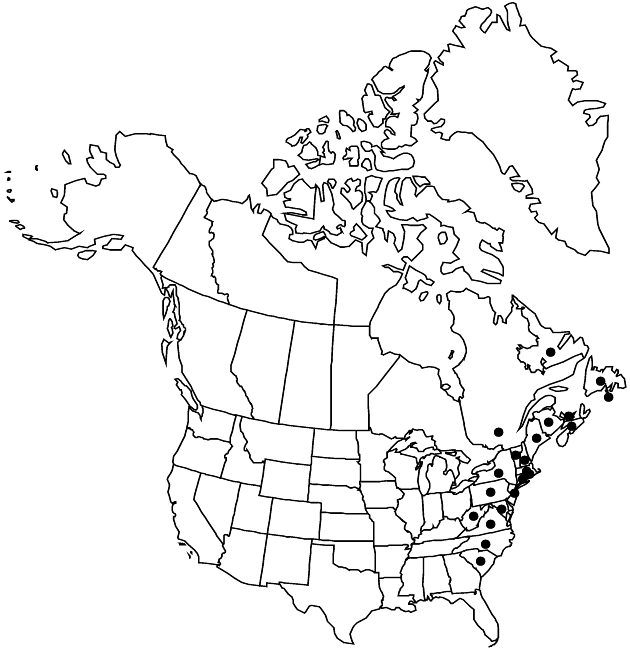Symphyotrichum novi-belgii
Phytologia 77: 287. 1995.
Perennials, 17–100 (–140) cm, loosely to densely colonial or sometimes cespitose; long-rhizomatous. Stems 1–5+, erect (straight, stout to slender, often reddish), glabrous and hairy in lines distally or sometimes wholly strigoso-pilose (var. villicaule). Leaves thick, firm, ± fleshy, margins scabrous, apices mucronate, faces glabrous, abaxial midveins sometimes villosulous (var. villicaule); basal withering by flowering, petiolate (petioles winged, bases sheathing), blades ovate to ovatelanceolate or lanceolate, 17–60+ × 6–11+ mm, bases attenuate to cuneate, apices obtuse; proximal cauline withering by flowering, sessile or widely winged-petiolate (petioles clasping), blades lanceovate or obovate to elliptic to linear-lanceolate, 40–200 × 4–40 mm, bases cuneate or sometimes slightly attenuate, sometimes rounded or slightly auriculate, slightly clasping, apices acute to acuminate; distal sessile, blades lanceovate to linear-lanceolate, 13–62 × 3–15 mm, progressively reduced distally, bases cuneate or ± rounded, sometimes slightly auriculate, ± clasping, margins sparsely serrulate or entire. Heads in open to dense, paniculiform arrays, branches ± divaricate to ascending, leafy with remote, small, gradually reduced branch leaves. Peduncles 4–41 mm, glabrous or moderately pilose, bracts 1–3, lanceolate or ovate to linear-oblanceolate, subtending ones sometimes exceeding involucres, sometimes grading into phyllaries. Involucres campanulate, 6–9 mm. Phyllaries in 3–4 series, oblong-oblanceolate or spatulate (outer) or oblong-lanceolate to linear-lanceolate or linear (inner), ± unequal to subequal, bases indurate 1/5–1/3, margins hyaline, scarious, erose and sparsely ciliolate distally, green zones lanceolate, sometimes foliaceous, apices spreading to ± squarrose, usually acute to obtuse or ± long-acuminate, mucronulate, faces glabrous. Ray-florets 15–35; corollas usually blue-violet or purple, rarely pink or white, laminae (6–) 10–19 × 0.9–2.1 mm. Disc-florets 28–68; corollas yellow becoming reddish-brown to purple, 4–7.5 mm, tubes shorter than funnelform-campanulate throats, lobes lanceolate, 1–1.5 mm. Cypselae tan to brown, obovoid, compressed, 2–4 mm, 4–6-nerved, faces sparsely strigose to glabrate; pappi sordid to yellowish, 4–6 mm.
Phenology: Late Aug–Oct(–Nov).
Habitat: Woods and open places, especially sandy soils
Elevation: 0–1400[–2300] m
Distribution

Ala., Ark., Fla., Ga., Ill., Kans., La., Mo., Nebr., N.Mex., N.C., Okla., S.C., Tex., Mexico (Coahuila)
Discussion
varieties 4 (4 in the flora)
Symphyotrichum novi-belgii is morphologically variable (J. Labrecque and L. Brouillet 1996) and this variation appears to have both genetic and environmental bases. The name Aster foliaceus has been misapplied to members of this complex in eastern North America; various other names also have been misused at the specific or subspecific levels. These are clarified under the varieties below. Hybrids of S. novi-belgii, probably mostly var. novi-belgii or var. elodes, have been reported with S. lanceolatum and S. lateriflorum.
Selected References
Lower Taxa
Key
| 1 | Proximal stems uniformly and densely hirsute; Maine, New Brunswick, and adjacent Quebec | Symphyotrichum novibelgii var. villicaule |
| 1 | Proximal stems glabrous or slightly hirsute in lines | > 2 |
| 2 | Leaves: lengths 4–5 times widths, bases strongly clasping; plants robust, compact; New Brunswick | Symphyotrichum novibelgii var. crenifolium |
| 2 | Leaves: lengths 7–10+ times widths, bases ± clasping or subclasping; plants slender to ± compact | > 3 |
| 3 | Leaves lance-ovate or lanceolate to oblanceolate, lengths less than 10 times widths, bases ± clasping | Symphyotrichum novibelgii var. novibelgii |
| 3 | Leaves linear-lanceolate, lengths more than 10 times widths, bases subclasping | Symphyotrichum novibelgii var. elodes |
"thick" is not a number.